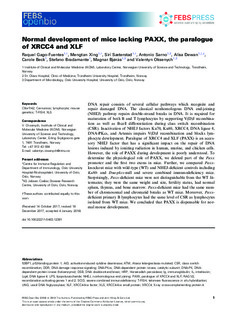| dc.description.abstract | DNA repair consists of several cellular pathways which recognize and repair damaged DNA. The classical nonhomologous DNA end-joining (NHEJ) pathway repairs double-strand breaks in DNA. It is required for maturation of both B and T lymphocytes by supporting V(D)J recombination as well as B-cell differentiation during class switch recombination (CSR). Inactivation of NHEJ factors Ku70, Ku80, XRCC4, DNA ligase 4, DNA-PKcs, and Artemis impairs V(D)J recombination and blocks lymphocyte development. Paralogue of XRCC4 and XLF (PAXX) is an accessory NHEJ factor that has a significant impact on the repair of DNA lesions induced by ionizing radiation in human, murine, and chicken cells. However, the role of PAXX during development is poorly understood. To determine the physiological role of PAXX, we deleted part of the Paxx promoter and the first two exons in mice. Further, we compared Paxx-knockout mice with wild-type (WT) and NHEJ-deficient controls including Ku80- and Dna-pkcs-null and severe combined immunodeficiency mice. Surprisingly, Paxx-deficient mice were not distinguishable from the WT littermates; they were the same weight and size, fertility status, had normal spleen, thymus, and bone marrow. Paxx-deficient mice had the same number of chromosomal and chromatid breaks as WT mice. Moreover, Paxx-deficient primary B lymphocytes had the same level of CSR as lymphocytes isolated from WT mice. We concluded that PAXX is dispensable for normal mouse development. | nb_NO |

